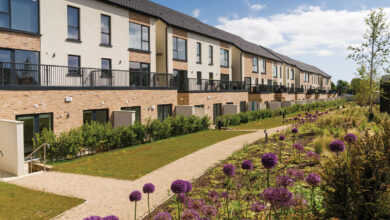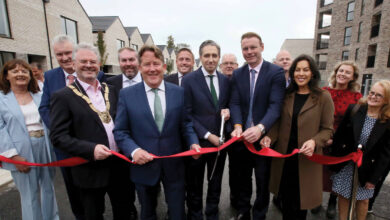Delivering social housing
Bairbre Nic Aongusa, Assistant Secretary in the Department of Environment, Community and Local Government talks to Owen McQuade about the implementation of the Government’s social housing strategy and wider aspects of housing policy.
Bairbre Nic Aongusa is Assistant Secretary in the Department of Environment, Community and Local Government with responsibility for housing policy. She oversees the delivery of the Government’s new social housing strategy, Social Housing 2020: Support, Supply and Reform.
The vision in the strategy is “securing good quality housing, at an affordable price, in a sustainable community.” The key element of the social housing strategy is a commitment to provide sufficient social housing to address all of the housing needs that are currently on the waiting lists. There are around 90,000 people on the social housing waiting lists and the strategy sets out a target to address all of that over the next six years.
There are two key elements of the strategy. 35,000 additional units will be provided, built or acquired and in addition 75,000 units are to be provided through the private rental sector. This total of 110,000 units provides a “cushion for the expected demographic increase in the population”.
Nic Aongusa says that: “It’s an extremely ambitious strategy, but it comes on the back of a period where, over the last five or six years, there was very little social housing being built.” During that period, a social housing leasing scheme was developed in order to avail of vacant privately-owned housing to provide for those in housing need.
“We’re now in a situation where a lot of landlords are trying to get out of the leasing market and we have a shortage of supply as a result. So, it is essential for us to start building again.”
“We received a very good package in the Budget last year. The total cost of the strategy is going to be £3.8 billion. We have a capital funding envelope to cover us for the next three years and we have issued targets to each local authority for their building and leasing programmes out to 2017.”
The implementation of the strategy is in two phases – one is the first three years 2015-2017 and phase two is 2018-2020. Of the 35,000 new units, 22,000 of those are going to be built or acquired, 11,000 will be leased and the balance via a programme of returning vacant local authority units to use.
“In 2014, we delivered 6,500 units under various programmes and our target for this year is very ambitious – over 7,500.”
Supply
Achieving the targets will be a significant challenge, particularly following a period of reduced investment and building due to the economic crisis. “We are coming out of a period where we had very little building activity over the last five or six years. The funding and the political commitment to underpin the Strategy are there. We are very conscious that delivering on the Strategy also requires upscaling in capacity here in the Department, as well as in local authorities and approved housing bodies; and we are well down the road towards achieving that objective,” says Nic Aongusa.
Added to this is the fact that the economy is also picking up with private building beginning to recover, which will have a knock-on effect in terms of availability of skilled professionals and getting suitable sites.
On the issue of sites Nic Aongusa is reasonably optimistic: “Local authorities do have quite a land bank built up and the Housing Agency is working very closely with us in mapping all the available sites that are owned by the State.”
“In the next few years, we are going to be focusing on Exchequer funded build and acquisition. For the second phase of the strategy post-2017, we are putting in place mechanisms to deliver off balance sheet funding. These are new funding models such as an SPV (Special Purpose Vehicle) and public private partnerships. These will be models whereby private finance will be raised for the delivery for social housing. This is because under the new European rules, there are limits on the capital expenditure the Government can fund directly so leveraging private finance to help in the delivery of infrastructure is one of our key objectives.”
More than a building
Nic Aongusa has been in housing policy for one year now and actively sought the job, as she sees housing as a key policy area. “Housing was a major element in the downfall of our economy but it is going to be a key part in our recovery. So I see it as an opportunity for us to rebuild, and try new solutions, but also to learn from our mistakes and make sure we don’t repeat the ‘boom and bust’ cycle again,” she explains.
Although our discussion has focused on delivering the number of units within the new social housing strategy, Nic Aongusa is keen to stress that housing policy is primarily “about people and not buildings”.
“The focus is on getting units built and there’s a lot of concern about getting supply kick started at the moment which is absolutely right. However, we do need to remember that we are building homes – not just buildings so it’s essential, for example, that we look after quality, and that we provide quality housing in sustainable communities.”
Encouraging mixed tenure is essential for sustainable communities, as is good planning to allow for social, educational, transport and other services to be put in place, “so that we don’t repeat the mistakes of the past and build massive big social housing estates with no infrastructure.”
The concept of regeneration for old or disadvantaged estates is being emphasised in the strategy and a social dividend is also a key part, with NAMA-owned properties being brought into use for social housing – over 1,000 of which have been delivered to date.
There are also new provisions to support the delivery of social housing coming in under the recently enacted Urban Regeneration and Housing Act 2015. Provisions include revisions to Part V of the Planning and Development Act which will require 10 per cent of all private housing developments to be made available for social housing. Nic Aongusa says Part V is “a major plank” of the strategy and “will ensure that social housing is provided alongside private housing as the construction sector picks up.”
Social inclusion is also an important part of the Strategy which includes: “Provision for older people, for people with disabilities, ensuring the needs of children are looked after, Travellers and a homelessness implementation plan. While we are very conscious of the urgency of delivering, we are not going to be pushing out massive delivery without bearing these issues in mind.”
“We are also conscious that we need to use all available options to maximise supply. Even though a lot of the emphasis and interest, particularly in the media, is in construction, that is not our sole focus. We are making use of leasing and the new HAP [Housing Assistance Payment] programme in the private rental sector.”
She describes HAP as a “major cultural change” for local authorities, but one which they appear to be embracing with enthusiasm.
Challenges
Looking to the future, “the key challenges are delivery of additional units, Part V and then, the private rented sector,” stresses Nic Aongusa.
“Making provisions like Part V real” will be a challenge, admits Nic Aongusa. “Part V in the past was less successful than it had originally been intended and I think it is essential if we are to build sustainable communities that the Part V provisions are made to stick and the provisions in the new Act are designed to overcome some of the difficulties that Part V faced in the past.”
Nic Aongusa sees the need for a programme of reform of the private rented sector. “At the moment, we are looking at all of the available policy options with a view to producing a policy paper by the Autumn.”
“For people who qualify for social housing, there are a range of supports available and the key issue is supply. But for people who are at the top end of the income brackets for social housing, or are maybe just above the income level, there is very little for them. They are the ones who are being squeezed out of the private rental market at the moment and they are also unlikely to qualify for a mortgage for the foreseeable future. So we need to consider an affordable rental option for people in that bracket.”
Nic Aongusa says many of these people would be key workers such as nurses, junior officials and other professional young people starting out in their careers. “They can’t afford housing in the areas where the jobs are – in the greater Dublin and other urban areas. We’re working with the Housing Agency, NESC, some of the approved housing bodies and indeed, some private financers to come up with various proposals for how an affordable rental scheme would look.”







